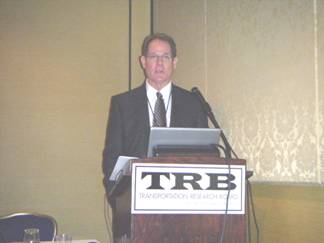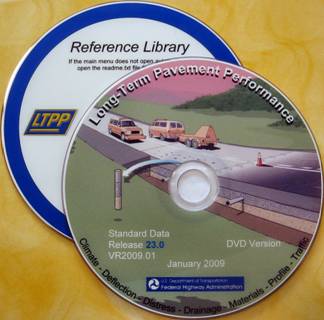U.S. Department of Transportation
Federal Highway Administration
1200 New Jersey Avenue, SE
Washington, DC 20590
202-366-4000
Federal Highway Administration Research and Technology
Coordinating, Developing, and Delivering Highway Transportation Innovations
|
LTPP News This newsletter is an archived publication and may contain dated technical, contact, and link information. |
|
| Publication Number: FHWA-HRT-09-034 Date: Winter 2009 |
Publication Number:
FHWA-HRT-09-034
Issue No: Vol. 5 No. 1 Date: Winter 2009 |
| Email Distribution List |
|
| Contact |
Customer Service
|
The 88th Annual Transportation Research Board (TRB) Meeting was held the second week in January. As in previous years, the Long-Term Pavement Performance Program (LTPP) kicked off the week with the LTPP State Coordinators' Meeting. This 21st coordinators' meeting answered the question: "Where do we go from here with the LTPP program?"
Gary Henderson, Director of the Office of Infrastructure Research and Development, provided opening remarks on behalf of the Federal Highway Administration (FHWA) management. He discussed the "buzz" word in Washington these days — change. One thing we know for sure is that change is a constant that we can count on. For example, there have been changes at the Turner-Fairbank Highway Research Center (TFHRC) with recent retirements and staff moving into new roles. Mr. Henderson mentioned the fact that the FHWA received additional money from Congress due to a technical correction of the Safe, Accountable, Flexible, Efficient Transportation Equity Act: A Legacy for Users (SAFETEA-LU). Some of this money was used to upgrade part of the TFHRC facility. The FHWA is currently operating under a continuing resolution that expires March 6, 2009, and has received 43 percent of funding for the year. The FHWA is looking at new and innovative ways to fund projects. At the time of this meeting, Mr. Henderson had no updated information on the new Highway Bill, but he expects that the new Economic Stimulus Plan will have a positive impact for the highway community. The FHWA committed to manage the LTPP program for nearly 17 years and that commitment will continue. In fact, the LTPP program was used as the framework for the Long-Term Infrastructure Program (LTIP), part of the office's strategic plan that includes highways and bridges. Mr. Henderson closed with the remark, "We are thankful to you, our partners, for these past years, but we still need and want your help!"
Bill Temple, Vice Chairman for the TRB LTPP Committee, stated that the LTPP database is the premier product of the program. The fact that it contains more research quality data than anywhere else makes it a national treasure. Over the course of the years, the program had nearly 2,500 test sections that were being monitored. Now after 19 years, nearly 1,200 test sections are still providing good performance data. Approximately 500 of these sections still have the potential to provide data that is needed in particular rigid pavements. Many agencies are still using the American Association of State Highway Officials (AASHO) Road Test models from the 1960s and there is a need to update these empirical models. At that time, less environmental data was collected and truck loads were much lighter. LTPP will hopefully provide a new generation of pavement performance data for the next 50 years that can fuel the development of 21st century pavement performance models.

Bill Temple addressing the LTPP State Coordinators at the 88th Annual TRB Meeting.
Mr. Temple provided additional comments on the Committee's position on the future of LTPP. He remarked that the LTPP program should be positioned so that it survives regardless of changes in administration. He reminded the States that this is your database—;so use it!
Aramis López, LTPP Team Leader, gave a 20-year retrospective of the program. He started with the timeline for the program, and then moved into a discussion on the equipment selection decisions and data collection period. There have been major technology changes since LTPP began. One very important observation that should be made about the program is that LTPP management has kept the database current with technology changes. Perhaps the most entertaining part of Mr. Lopez's presentation were the photos he showed of the people who participated in LTPP over the last two decades. Literally hundreds of people have contributed to the program and each and every one has contributed to its success. There are quite a few early contributors who continue to be advocates of the mission and results of LTPP, which is a testament to the importance and continued relevance of the program.
Jack Springer, LTPP Team Member, discussed what is next for the LTPP test sections. Due to budget shortfalls, LTPP had to reduce the monitoring cycle for the test sections; however, LTPP did not close-out the sites. With the additional money available as part of the technical correction bill mentioned earlier, LTPP will resume the monitoring of test sections this spring. Monitoring will include visual distress and profile surveys only. LTPP asks that each State tell us the status of LTPP test sites. We need to know if any of the test sites were overlaid or had some maintenance treatment performed. If the test signs are down or pavement markings need to be refreshed, we ask that you do this prior to the resumption of monitoring activities at the site. Mr. Springer pointed to a 40-year old rigid pavement in Virginia as an example of a long-lasting pavement that is still going strong to illustrate the value of continued data collection. Additional data on test sections, such as this one, may provide clues to the reasons for such outstanding longevity.
Cheryl Richter, Resource Program Manager for the Office of Infrastructure Research and Development, presented the strategic plan for the office and how LTPP is a key component of this plan. In fact, the LTIP will build on what has been done under LTPP and integrate the new Long-Term Bridge Program (LTBP). Many of our partners have expressed concern about the activities that will not be completed by September 2009, but must be done in order to reap the full benefits of this long-term research effort. The FHWA has listened and taken appropriate action to address these concerns. The key items that must be properly completed by LTPP are included in the Highways of the Future Strategic Plan for the Office of Infrastructure Research and Development.
Robert Raab, TRB Senior Program Officer, talked about how many people have volunteered their services to help guide the program these past
19 years. The volunteers are from State Highway Agencies, academia, and the private sector. They review, comment, and in some cases redirect the course of the program. More than 183 people putting in a collective 40,000 plus hours preparing and attending meetings helped to make LTPP the success that it is today.
This article highlights some of the key information presented at the meeting. Copies of the PowerPoint® presentations from this meeting and the LTPP Box Session will be mailed to all our LTPP State Coordinators. If you are not a Coordinator, but would like to receive a copy of the presentations, contact LTPP Customer Support Services at ltppinfo@fhwa.dot.gov or (202) 493-3035.

The SDR 23 DVD package.
Data from the FHWA's LTPP program is accessible with the new Standard Data Release (SDR) 23. The most current release of the world's largest pavement performance database was made available to the public at the 88th Annual TRB Meeting in January 2009. LTPP SDR 23 is a single DVD that contains the pavement performance data from nearly 2,500 test sections in Microsoft Access® format and can be obtained at no charge.
LTPP SDR 23 includes the formal release of level 1 TRF_MEPDG* inputs. The SDR 23 also includes a new table view that presents the layer structure for each test section in a more direct and accessible manner. In addition, the release contains computed frost-depth data for the seasonal monitoring sites, and updated climate and Specific Pavement Study (SPS) test section coordinate data.
The release also contains the latest version of the Database User Reference Guide, a tutorial on "Accessing LTPP Data," and other information, including details on changes made since previous data releases. We strongly suggest that you request a copy of this new version of the SDR if you are currently using an older version because we are continually working to improve the quality of existing data and modifications, additions, and deletions may have occurred that could affect analysis results.
Also available with the SDR is a Reference Library DVD of LTPP documents that contains research reports, technical briefs, resource documents, and database utilities such as Table Navigator. The Table Navigator application contains definitions for database fields and codes and allows users to expand, collapse, and search the LTPP database structure. To obtain a copy of SDR 23, or for more information about the LTPP program, contact LTPP Customer Support Services at ltppinfo@fhwa.dot.gov or (202) 493-3035.
Periodically, LTPP will share database tips to give its users a better understanding of how the database works. This issue gives the users tips on how to use the Table Navigator software tool that is included with SDR 23.

The LTPP Table Navigator opening screen.
The LTPP Pavement Performance Database is described as a large data warehouse. Navigating your way through the more than 500 tables and 10,000 data elements is a challenge to even the most veteran LTPP technologist. LTPP developed the Table Navigator software to provide data users a fast and easy means of finding their way around the LTPP "data warehouse."
Table Navigator begins by presenting a list of tables and descriptions grouped by database module. The order of presentation of the table names can be altered with the sorting alternatives at the bottom of the screen.
To see a listing of the fields in a table, including their units and descriptions, a user simply double clicks on the table name. To see an explanation of the meaning of a field that contains a code, a user just double clicks on the code name.
The search function provides a very powerful feature to search through a set of user specified fields to find data of interest.
The Windows based version of Table Navigator is distributed free of charge as part of the LTPP SDR. Otherwise, an on-line version of the software can be downloaded at http://www.ltpp.org/user_corner.shtml. The software is updated annually to match each SDR.
Watch for more database tips in upcoming issues.
In 2008, LTPP completed the Weigh-in-Motion (WIM) installations for select SPS test sites. This work, being performed under the LTPP SPS Traffic Data Collection Pooled Fund Study, TPF-5(004), is now collecting research quality traffic data at 28 SPS test sites across the country. Research quality data is defined to be at least 210 days of data of known calibration meeting LTPP's performance requirements. The majority of the sites are using the LTPP Classification Scheme. This Scheme has been tested and proved to work very well in different regions of the country.
Of the 28 sites, seven were installed by the State Highway Agency while the remaining sites were installed by the LTPP contractor. The sites are validated each year using test trucks of known weights and the data is checked daily against a set of quality parameters to make sure the WIM system is operating properly.
With the last of the WIM installations done in 2008, the pooled fund study will run through 2013 to collect at least 5 years of research quality data for the sites. A more detailed article will be written on this study as we begin to analyze the data from these sites.
For more information about the traffic pooled fund study, contact Deborah Walker at deborah.walker@fhwa.dot.gov or (202) 493-3068.
To learn more about the LTPP program and products, visit www.fhwa.dot.gov/pavement/ltpp/index.cfm.